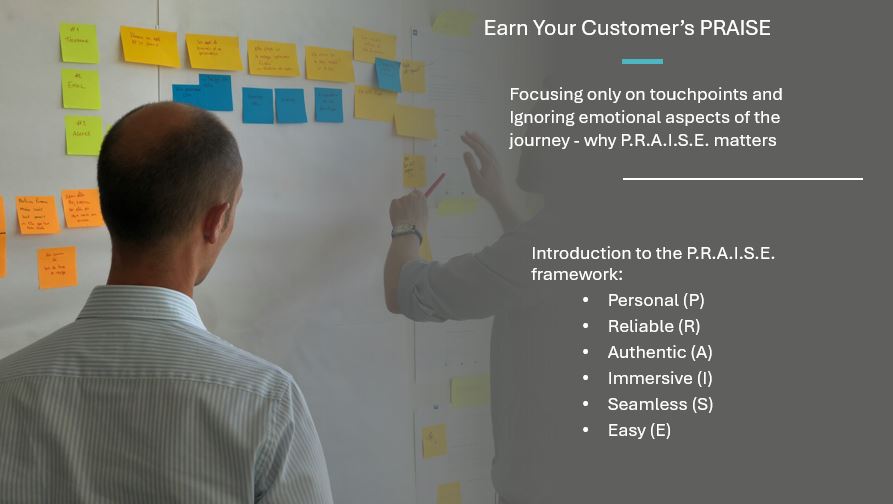In my recent LinkedIn article, I introduced you to the PRAISE Framework, my proprietary approach to Customer Journey Mapping. If you haven’t yet read it, I encourage you to check it out here to get the full background on how PRAISE elevates traditional journey mapping by focusing not only on transactions and touchpoints but also on the emotional and sensory experiences that drive loyalty.
Today, I’m going to take you deeper into each element of PRAISE—Personal, Reliable, Authentic, Immersive, Seamless, and Easy—and share how you can integrate these principles into your own journey mapping process.
Personal – Making It Matter
A customer experience is truly powerful when it feels uniquely crafted for the individual. Personalization goes beyond simply addressing a customer by name; it’s about anticipating needs, understanding preferences, and making the customer feel seen and valued. When brands achieve this, they unlock higher engagement, loyalty, and advocacy.
Examples of Personalization in Journey Mapping:
- Proactive communication based on past behaviors and preferences.
- Customized content that speaks directly to the customer’s unique journey.
- Loyalty programs that are tailored to individual habits and purchase patterns.
By embedding Personal into your journey maps, you’re not just tracking interactions—you’re capturing the emotional impact of feeling understood and valued.
Reliable – Consistency Builds Trust
Reliability in customer experience is about delivering on your promises every single time. Customers should feel confident that each interaction, regardless of channel or touchpoint, will meet their expectations. Reliability builds trust—and trust drives loyalty.
Examples of Reliability in Journey Mapping:
- Consistent service quality across digital and physical channels.
- Predictable and timely responses to customer inquiries.
- Seamless transitions between touchpoints without losing context or information.
Mapping reliability allows you to spot gaps where consistency may falter, empowering you to optimize for a smoother, more dependable experience.
Authentic – Building Genuine Connections
Authenticity is the heartbeat of customer trust. It’s about showing up in a way that’s real, transparent, and true to your brand values. Customers are more attuned than ever to scripted or disingenuous interactions; they crave honesty and transparency.
Examples of Authenticity in Journey Mapping:
- Real-time social engagement that reflects genuine brand voice.
- Transparent communication during service disruptions or changes.
- Honest marketing that matches the actual experience.
Mapping authenticity helps you identify where scripted interactions feel forced or where transparency could be improved.
Immersive – Captivating the Customer
An immersive customer experience is one that fully engages the senses and creates lasting memories. It’s about crafting environments and interactions that draw customers deeper into the brand story, making them feel like active participants rather than mere observers.
Examples of Immersive Experiences in Journey Mapping:
- Virtual or augmented reality experiences that allow customers to explore products interactively.
- Sensory-driven touchpoints that go beyond sight and sound—think scent marketing or tactile interactions.
- Branded events that transport customers into the essence of the brand.
Mapping immersive experiences means identifying where you can elevate a touchpoint from transactional to transformative.
Seamless – Eliminating Friction, Elevating Flow
Seamlessness is about ensuring every interaction feels fluid and connected. Customers should never feel like they are moving from one department to another; it should always feel like one continuous brand experience.
Examples of Seamless Experiences in Journey Mapping:
- Unified digital experiences where customers can start on one device and finish on another without interruption.
- Consistent information sharing across departments, so customers never have to repeat themselves.
- Integrated communication that provides contextually relevant information at each touchpoint.
Mapping seamless experiences highlights gaps where friction may exist, paving the way for smoother, more engaging interactions.
Easy – Simplifying the Journey
At its core, an easy customer experience is about removing barriers and reducing effort. When customers find it effortless to engage with your brand, satisfaction and loyalty naturally follow.
Examples of Easy Experiences in Journey Mapping:
- Streamlined checkout processes that minimize clicks and eliminate unnecessary steps.
- Self-service options that empower customers to solve issues quickly.
- Clear and intuitive navigation across websites and apps.
Mapping for ease allows you to identify complexities and simplify the journey, creating a frictionless path for your customers.
When the PRAISE Framework is layered onto your Customer Journey Mapping, it transforms mere observations into actionable insights—enabling you to design experiences that are not only efficient but also emotionally resonant.
Ready to take your journey maps from good to unforgettable? Let’s earn your customers’ PRAISE.





